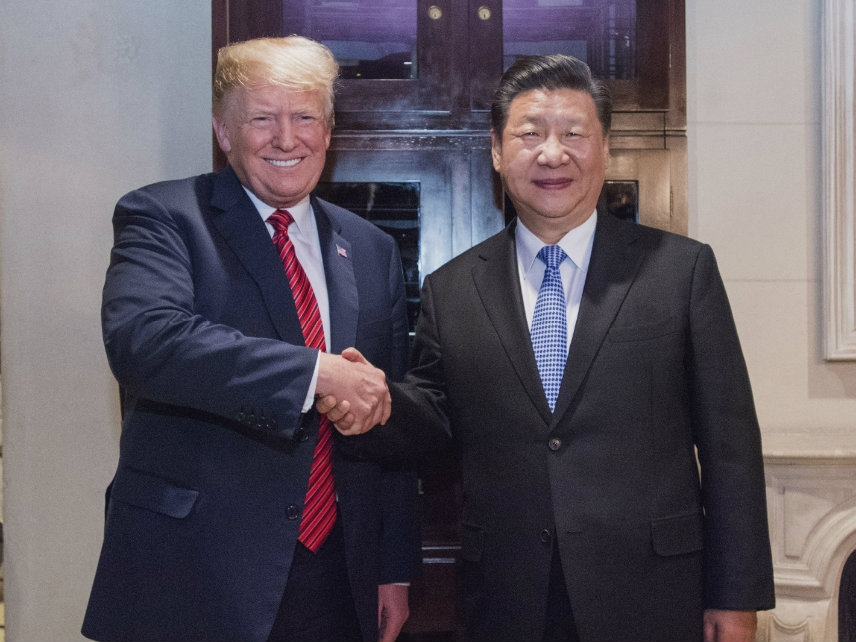Trump's G20 Deal With Xi Jinping Promises De-escalation of Trade War but Lacks Many Specifics
Saturday's deal seems to be a strategic retreat by the Trump administration.

When you're in a hole, the first thing to do is stop digging.
That's probably the best takeaway from the trade agreement between the United States and China that was announced Saturday at the G20 conference in Buenos Aires. The main outcome of the deal between presidents Donald Trump and Xi Jinping is that the United States won't escalate the trade war on January 1, the date when tariffs on billions of dollars of Chinese imports were set to increase to 25 percent from 10 percent. Instead, those tariffs will remain in place but at the current, lower rate.
That's surely good news, and it's the first indication since the U.S.–China trade war began in July that the two countries both want to reach a truce.
Still, describing this as an agreement—or even, indeed, as a truce—is probably giving it too much credit. Trump and Xi have agreed to avoid further escalation, but there is nothing in the read-outs provided by each nation that indicates a move towards reducing the current tariffs that have caused significant economic pain by raising prices for American manufacturers and by reducing American markets for Chinese exporters.
Take, for example, what the White House is holding up as a major part of the deal: that China "will agree to purchase a not yet agreed upon, but very substantial, amount of agricultural, energy, industrial, and other product[s] from the United States to reduce the trade imbalance between our two countries."
That's vague and rather unenforceable language. It also shows that Trump continues to be fixed on the so-called "trade deficit"—which has increased since his Chinese tariffs were imposed in July and sits at a record $300 billion over the first nine months of the year. It's unlikely that a one-time boost in purchasing American exports will change that, and it's not at all clear that China will be able to pressure domestic businesses into making those purchases while the tariffs it erected against American farm products are still in place.
For a look at what else the two sides have agreed to, check out this handy side-by-side from Bloomberg reporter Peter Martin.
Confused about what exactly Xi and Trump promised each other yesterday?
Here's a side-by-side comparison of the readouts from both sides. The U.S. on the left, China on the righthttps://t.co/5N7aISEdew@LucilleLiu @JDMayger @Jeffrey_Black pic.twitter.com/kVVCB8wiqI
— Peter Martin (@PeterMartin_PCM) December 2, 2018
The lack of specificity is not limited to the promise that China will purchase more agricultural goods. Throughout the entire "agreement," about the only quantifiable detail is the promise that America will go ahead and increase tariffs from 10 percent to 25 percent in 90 days if a better deal is not reached. But as trade lawyer and Cato Institute scholar Scott Lincicome points out, "with no joint statement and list of actual/concrete deliverables, how will both sides (and the public) measure success or failure in 90 days?"
The White House wants this agreement to be seen as a first step towards a real trade deal—and as evidence that its tariffs are bringing China to the negotiating table. But the details here suggest that Saturday's deal is a strategic retreat by the Trump administration. Trump gets a small political win and China gets to delay further escalation of the trade war by making vague promises about trying to buy more American farm goods. That's exactly what China wants, because time is on its side. As the costs of the trade war continue to pile up for American businesses—and if the recent stock market wobbles turn into something worse—Xi will be in a stronger bargaining position relative to Trump, who will face mounting political pressure to abandon the tariffs if there aren't solid results to show for them.
Delaying those 25 percent tariffs on Chinese imports will help American businesses and consumers, but it's too soon to determine if that delay brings us closer to the end of the trade war or if we're merely entering a temporary lull in hostilities.




Show Comments (87)